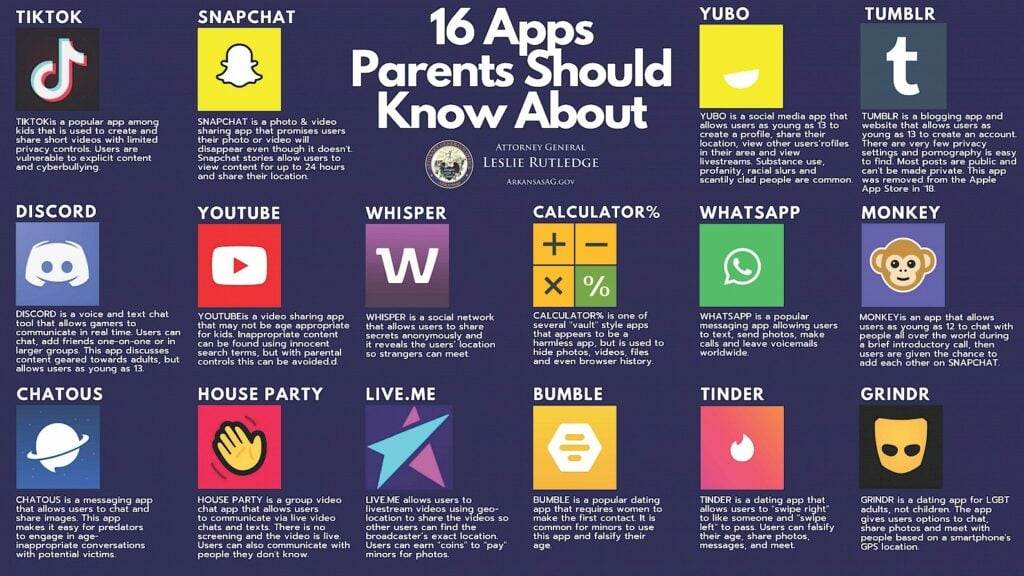With today’s smart phones, tablets, computers, gaming systems, and app technology the cyber world is a scary and dangerous place for everyone, but most especially our youth. Apps that are marketed and that target our youth can be very dangerous due to them being used to entice kids to try drugs and alcohol or for sexual solicitation. Sexual solicitation can be as simple as convincing a child to send a inappropriate picture of themselves to another person or arranging for the child to meet a complete stranger for an inappropriate relationship. Predators will use fake information, such as a false name, date of birth, and profile picture, to set up their profiles on the apps to hide their true identity.
We strongly encourage all parents, grandparents, and guardians to monitor your child’s electronic devices for any inappropriate acts. There are many creditable apps for you to be able to monitor the activity on your child’s phone and tablet usage.
Below is a partial list of popular apps that our youth use. It’s a never-ending cycle with new apps created on a daily basis. Research any and all apps that your child wants to download or use.
Microblogging Apps
Tumblr is like a cross between a blog and Twitter. It is a streaming scrapbook of text, photos, and/or video and audio clips. Users create and follow short blogs, or “tumblogs,” that can be seen by anyone online (if they’re made public). Many teens have tumblogs for personal use – sharing photos, videos, musings, and things they find funny with their friends.
What parents need to know:
Pornography is easy to find. This online hangout is hip and creative but sometimes raunchy. Pornographic images and videos and depictions of violence, self-harm, drug use, and offensive language are easily searchable.
Privacy can be guarded but only through an awkward workaround. The first profile a member creates is public and viewable by anyone on the internet. Members who desire full privacy must create a second profile, which they are able to password-protect.
Posts are often copied and shared. Reblogging on Tumblr is similar to re-tweeting. A post is reblogged from one tumblog to another. Many teens like – and, in fact, want – their posts to be reblogged.
Twitter is a microblogging tool that allows users to post brief, 140-character messages – called “tweets” – and follow other users’ activities. It is not only for adults. Teens like using it to share tidbits and keep up with news and celebrities.
What parents need to know:
Public tweets are the norm for teens. Though you can choose to keep your tweets private, most teens report having public accounts. You may want to talk to your kids about what they post and how a post can spread far and fast.
Updates appear immediately. Even though you can remove tweets, your followers can still read what you wrote until it is gone. This can get kids in trouble if they say something in the heat of the moment.
Live-Streaming Video Apps
YouTube is a video-sharing site and app. Videos here run the gamut, from commercial to educational to music videos to homemade clips. Many kids love YouTube and rely on it as a way of keeping up with popular culture; videos go “viral” when viewers share the clips they like. One of the Web’s most popular destinations for people of all ages, YouTube now curates its videos, suggesting clips and new “channels” based on what you’ve watched previously
What parents need to know:
There are many videos on YouTube that may not be age-appropriate for kids. The app includes a feature that lets you see how much time you’ve spent watching videos, and you can set reminders to turn off autoplay and take a break.
The site is entirely user-generated. It relies on its community to flag videos that violate YouTube’s terms of service (mostly for sexual content, language, and hate speech).
Innocent searches can produce inappropriate results. Violent and emotionally distressing pranks and stunts have been banned from the site, but parents will want to monitor activity.
Parent controls are available. YouTube does offer parents the ability to filter out objectionable content and comments using Safety Mode. However, Safety Mode doesn’t catch everything, and it’s easy to disable. YouTube also has channels by which users can access specialized content: YouTube Kids and YouTube Music.
Houseparty – Group Video Chat is a way for groups of teens to connect via live video. Two to eight people can be in a chat together at the same time. If someone who is not a direct friend joins a chat, teens get an alert in case they want to leave the chat. You can also “lock” a chat so no one else can join.
What parents need to know:
Users can take screenshots during a chat. Teens like to think that what happens in a chat stays in a chat, but that’s not the case. It is easy for someone to take a screenshot while in a chat and share it with whomever they want.
There is no moderator. Part of the fun of live video is that anything can happen, but that can also be a problem. Unlike static posts that developers may review, live video chats are spontaneous, so it is impossible to predict what kids will see, especially if they are in chats with people they do not know well.
LiveMe – Live Video Streaming allows kids to watch others and broadcast themselves live, earn currency from fans, and interact live with users without any control over who views their streams.
What parents need to know:
This app is associated with Tik Tok – including musical.ly. Because of the parent app’s popularity, this streamer is very popular, and many kids who use one app use the other too.
Kids can easily see inappropriate content. During our review, we saw broadcasters cursing and using racial slurs, scantily clad broadcasters, young teens answering sexually charged questions, and more.
Predatory comments are a concern. Because anyone can communicate with broadcasters, there is the potential for viewers to request inappropriate pictures or performances or to contact them through other social means and send private images or messages.
YouNow: Broadcast, Chat, and Watch Live Video is an app that lets kids stream and watch live broadcasts. As they watch, they can comment or buy gold bars to give to other users. Ultimately, the goal is to get lots of viewers, start trending, and grow your fan base.
What parents need to know:
Kids might make poor decisions to gain popularity. Because it is live video, kids can do or say anything and can respond to requests from viewers – in real time. Though there seems to be moderation around iffy content (kids complain about having accounts suspended “for nothing”), there is frequent profanity and occasional sharing of personal information with anonymous viewers.
Teens can share personal information, sometimes by accident. Teens often broadcast from their bedrooms, which often have personal information visible, and they sometimes will share a phone number or an email address with viewers, not knowing who is really watching.
Content can be unsettling. Teens even broadcast themselves sleeping, which illustrates the urge to share all aspects of life, even intimate moments, publicly – and potentially with strangers.
Texting Apps
GroupMe is an app that does not charge fees or have limits for direct and group messages. Users also can send photos, videos, and calendar links.
What parents need to know:
It is for older teens. The embedded GIFs and emojis have some adult themes, such as drinking and sex.
Teens are always connected. Without fees or limits, teens can share and text to their heart’s content, which may mean they rarely put the phone down.
Kik Messenger is an app that lets kids text for free. It is fast and has no message limits, character limits, or fees if you only use the basic features. Because it is an app, the texts will not show up on your kid’s phone’s messaging service, and you are not charged for them (beyond standard data rates).
What parents need to know:
Stranger danger is an issue. Kik allows communication with strangers who share their Kik usernames to find people to chat with. The app allegedly has been used in high-profile crimes, including the murder of a 13-year-old girl and a child-pornography case.
This app is loaded with covert marketing. Kik specializes in “promoted chats’’ – basically conversations between brands and users. It also offers specially designed apps (accessible only through the main app), many of which offer products for sale.
WhatsApp lets users send text messages, audio messages, videos, and photos to one or many people with no message limits or fees.
What parents need to know:
This app is for users 16 and over. Lots of younger teens seem to be using the app, but this age minimum has been set by WhatsApp.
It can be pushy. After you sign up, it automatically connects you to all the people in your address book who also are using WhatsApp. It also encourages you to add friends who have not signed up yet.
Discord started as a place for gamers to chat while playing video games but has become a bigger platform where users can use text, voice-chat, and video-chat to discuss a wide variety of topics.
What parents need to know:
There are public and private “servers” or discussion groups. Teens can join public groups, ask to join private ones, or start their own. The safest option is for them to join a private group with people they know in real life.
Some groups are more moderated than others, some are not safe for work (NSFW), and some are hate-filled. There are plenty of groups that are meant for adults only while some are reasonably tame and well moderated. If your kid is in one of the latter, the risk is much lower.
Photo & Video-Sharing Apps
Instagram lets users snap, edit, and share photos and 15-second videos, either publicly or within a private network of followers. It unites the most popular features of social media sites: sharing, seeing, and commenting on photos. It also lets you apply fun filters and effects to your photos, making them look high-quality and artistic.
What parents need to know:
Teens are on the lookout for “likes.” Similar to the way we use Facebook, teens may measure the “success” of their photos – even their self-worth – by the number of likes or comments they receive. Posting a photo or video can be problematic if teens are posting to validate their popularity.
Public photos are the default. Photos and videos shared on Instagram are public unless privacy settings are adjusted. Hashtags and location information can make photos even more visible to communities beyond a teen’s followers if his or her account is public.
Kids can send private messages. Instagram Direct is like texting with photos or videos and you can do it with up to 15 mutual friends. These pictures don’t show up on their public feeds. Although there’s nothing wrong with group chats, kids may be more likely to share inappropriate content with their inner circles.
Tik Tok – Real Short Videos is a performance- and video-sharing social network that mostly features teens lip-synching to famous songs but also includes some original songwriting and singing. Users can build up a following among friends or share posts publicly.
What parents need to know:
Songs and videos contain lots of iffy content. Because the platform features popular music and a mix of teen and adult users, swearing and sexual content are commonplace.
There are often comments not appropriate for younger users. Though lots of comments are kind, videos often have comments about the performer’s body or other sexual references. Because this app is used by both adults and kids under 13, some comments may not be suitable for teens.
Gaining followers and fans feels important. Teens want a public profile to get exposure and approval, and many are highly motivated to get more followers and likes for their videos. Because of this, teens may post inappropriate or outrageous things to draw attention.
Self-Destructing/Secret Apps
Calculator%. This is a popular hidden-photo vault app where users can place photos to keep them out of view by parents and friends. These apps are disguised as one thing (calculator, a game or a file manager) but serve as a password protected vault where users can stash secret pictures.
What parents need to know:
Cell phone cameras can be misused. If kids are hiding photos, there is a pretty good chance it is because the photos are inappropriate.
You can check to see if your child’s phone has this type of hidden-photo app opening the phone’s app store and searching the terms “secret” or “vault.” If Calculator% or other hidden-photo apps are not on the phone, the word “GET” will appear next to the app. If the app is already on the phone, the word “OPEN” will appear. Because there are hundreds of these apps, you may need to scroll through a few pages.
You can set parental controls on your child’s phone so that they cannot download apps without first receiving your permission.
Chatous.This is a messaging app that randomly matches users with others from all over the world.
What parents need to know:
Stranger danger concerns. This app is specifically designed to put users in contact with strangers and allows them to send disappearing messages, so parents will find it difficult to oversee use of this app. There is no content moderation outside of the block and report features available to users.
Many adults use Chatous to be flirty with strangers.
Common complaints about this app include that some users pretend to be a member of the opposite gender and that some users send lewd photos and videos.
Snapchat is a messaging app that lets users put a time limit on the pictures and videos they send before they disappear. Most teens use the app to share goofy or embarrassing photos without the risk of them going public. However, there are lots of opportunities to use it in other ways.
What parents need to know:
It is a myth that Snapchats go away forever. Data is data. Whenever an image is sent, it never truly goes away. (For example, the person on the receiving end can take a screenshot of the image before it disappears.) Snapchats can even be recovered. After a major hack in December 2013 and a settlement with the FTC, Snapchat has clarified its privacy policy, but teens should remain wary.
It can make sexting seem OK. The seemingly risk-free messaging might encourage users to share pictures containing images that are sexual in nature.
There is a lot of iffy, clicky content. Snapchat’s Discover feature offers a grab-bag of articles, videos, and quizzes from magazine publishers, TV networks, and online sources mostly about pop culture, celebrities, and relationships.
The Snap Maps function displays your location on a map in real time. The biggest risk with Snap Map is a teen having their location seen by all their friends – since some of their Snapchat contacts may not be real friends. Unless there’s a specific event and it makes it easier for friends to know each other’s location, it is best to leave Snap Maps off or use it in Ghost Mode.
Whisper is a social “confessional” app that allows users to post whatever is on their minds, paired with an image. With all the emotions running through teens, anonymous outlets give them the freedom to share their feelings without fear of judgment.
What parents need to know:
Whispers are often sexual in nature. Some users use the app to try to hook up with people nearby, while others post “confessions” of desire. Lots of eye-catching, nearly nude pics accompany these shared secrets.
Content can be dark. People normally don’t confess sunshine and rainbows; common Whisper topics include insecurity, depression, substance abuse, and various lies told to employers and teachers.
Although it is anonymous to start, it may not stay that way. The app encourages users to exchange personal information in the “Meet Up” section.
Chatting, Meeting and Dating Apps
Bumble, a dating app that has a section for users as young as 13. Very similar to Tinder, but girls must always send the first message. This app is promoted as a dating app that promotes healthy, respectful relationships.
What parents need to know:
Kids and adults lie about their ages on this and other apps. There is no way to prevent adults from creating fake accounts as a way to prey on children.
This app encourages contact with strangers.
Grindr. The most popular dating app for gay, bisexual and transgender adults and bills itself as “the world’s largest LGBTQ+ mobile social network.”
What parents need to know:
This is an app for adults only. This app is rated 17+ in the Google Play app store and 18+ in iTunes. While it can be used innocently, Grindr is primarily used by adults as a dating app. Language and images on the app reflect that.
Personal information may not be secure. This app incorporates geolocation functionality that allows its users to view others who are closest to them. Research has indicated that the app may not securely store users’ location data, putting them at risk.
Monkey – Have Fun Chats. If you remember Chatroulette, where users could be randomly matched with strangers for a video chat, this is the modern version. Using Snapchat to connect, users have 10 seconds to live video-chat with strangers.
What parents need to know:
Lots of teens are using it. Because of the connection with Snapchat, plenty of teens are always available for a quick chat, which often leads to connecting via Snapchat and continuing the conversation through that platform.
Teens can accept or reject a chat. Before beginning a chat, users receive the stranger’s age, gender, and location and can choose whether to be matched or not.
MeetMe: Chat and Meet New People. The name says it all. Although not marketed as a dating app, MeetMe does have a “Match” feature where users can “secretly admire” others, and its large user base means fast-paced communication and guaranteed attention.
What parents need to know:
It is an open network. Users can chat with anyone who is online, as well as search locally, opening the door to potential trouble.
Lots of details are required. First and last name, age, and ZIP code are requested at registration, or you can log in using a Facebook account. The app also asks permission to use location services on your teens’ mobile devices, meaning they can find the closest matches wherever they go.
Omegle is a chat site that puts two strangers together in their choice of a text chat or a video chat. Being anonymous can be very attractive to teens, and Omegle provides a no-fuss way to make connections. Its “interest boxes” also let users filter potential chat partners by shared interests.
What parents need to know:
Users get paired up with strangers. That is the whole premise of the app. And there is no registration required.
This is not a site for kids and teens. Omegle is filled with people searching for chats that are sexual in nature. Some prefer to do so live. Others offer links to porn sites.
Language is a big issue. Since the chats are anonymous, they are often much more explicit than those with identifiable users might be.
This helpful article was furnished by the Izard County Sheriff’s Department.






